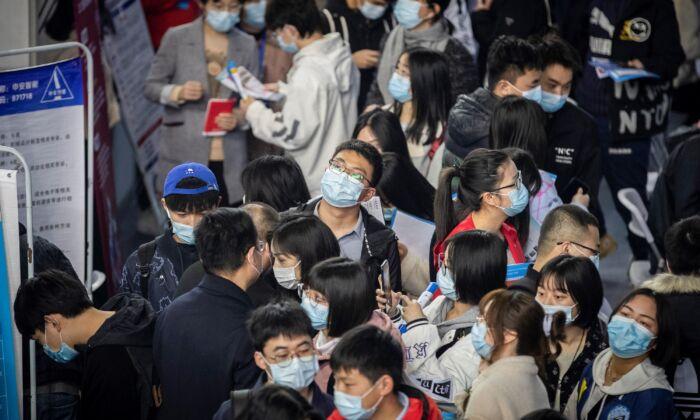China’s State Council and National Health Commission held a press conference on Jan. 13 to share information on the country’s recent pandemic control measures. It turned out to be another round of lies and deception from so-called medical experts.
Journalists from Chinese and Hong Kong-based media participated in the deception by asking the public health officials canned questions.
‘There Won’t Be Large-Scale Resurgence’
According to a transcript published on the National Health Commission website, a reporter from state-run media Xinhua asked: “There are currently one high-risk and 73 medium-risk areas across the country ... Will there be a resurgence?”Feng Zijian, deputy director of China’s Centers for Disease Control and Prevention (CDC), replied, “Multiple localized and sporadic outbreaks have occurred. We have issued guidance on pandemic prevention and control measures, so that the outbreaks can be detected and controlled as soon as they emerge. The measures we deploy can guarantee that there won’t be any large-scale resurgence.”
Several Chinese cities are currently experiencing a large-scale resurgence of cases. As a matter of fact, many countries around the world are in the midst of a more serious winter outbreak. Yet, the Chinese authorities claim that there won’t be any significant resurgence.
The situation is similar to the lie they told last year: “There is no evidence showing that the novel coronavirus can spread from person to person.”
Bizarre Vaccine Efficacy Data
A reporter from the Hong Kong Economic Herald asked: “My question is about CoronaVac developed by China’s Sinovac. How are the clinical trials going? Do the safety and effectiveness meet requirements?”Yin Weidong, chairman of the Beijing-based state-run drug company, was also at the presser. He replied, “Phase III clinical studies have been conducted in Brazil, Turkey, Indonesia, and Chile ... The main research data has now come out one after another ... In Turkey, the efficacy rate reached 91.25 percent. In Indonesia, it is 65.3 percent. In Brazil, the efficacy rate against severe illness and hospitalization is 100 percent. For the group who must be hospitalized for treatment, the efficacy rate is 78 percent. For [frontline] medical staff, who are classified as high-risk, the overall efficacy rate reached 50.3 percent.”
Apparently, Yin knew that this efficacy rate is too low, so he came up with bizarre statistics—100 percent protection against severe illness and hospitalization; 78 percent for people who must go to the hospital for treatment.
It is difficult to know where this data came from. The vaccine has an efficacy rate of 50.3 percent for medical staff. Then how could the “efficacy rate for severe illness and hospitalization” reach 100 percent? And how is it that the efficacy rate for hospitalized patients reached 78 percent?
There are only two possible explanations: either the chairman fabricated data, or there is no sensible conclusion from the clinical trials.
High Percentage of False Negatives
When replying to a question about the latest outbreaks in Shijiazhuang city, Hebei Province, Feng from China’s CDC said, “During the first round of nucleic acid testing, we failed to identify infected patients because there is a ‘window period’ for those newly infected people. They were diagnosed in the follow-up testing.”However, to cover up the low accuracy rate, Chinese experts began using the term “window period.” If there really is a “window period,” what use is it to organize mass testing before the virus is detectable? How dangerous is it to have people crowd together while waiting to get tested? The mass testing could well be a political show, and most likely there are huge financial interests behind the faulty testing kits.
Moreover, during that supposed window period, those virus carriers can go around undetected. Isn’t it a big lie for the Chinese authorities to tell the public that the pandemic is controllable?
As a matter of fact, their new lies reveal that their previous assertions were also lies.
Asymptomatic Person Less Likely to Spread the Virus?
While addressing a question from state broadcaster CCTV on the risk of asymptomatic carriers, Feng said, “They are able to spread the virus. However, compared with normal patients who display symptoms, their transmissibility risk is one-quarter to one-third that of normal patients, which is relatively low.”Shifting Blame
When a reporter expressed concern about a recent incident of a superspreader passing the virus to 33 people, Feng said it is difficult to explain why some patients are superspreaders. In addition, he said the recent outbreaks in rural areas appear to be very different and more challenging than before, and at present he does not have a clear explanation for them.Although he failed to answer questions that require professional knowledge, he still acted as a propaganda official. China’s propaganda department has repeatedly blamed other countries for bringing the virus to China, despite no evidence to back up their claims.
“As you all know, several outbreaks were caused by frozen food and non-frozen food imported from other countries,” Feng said. “These foods were contaminated with the virus before they arrived in China. In cold weather, the virus survives longer on surfaces and objects—that explains why the outbreak in winter is more serious. Secondly, the pandemic is currently very serious in other countries, so there are more chances that the virus is brought here either by travelers or imported goods. That is why we recently have more outbreaks than before.”
The pandemic press conference was actually a mishmash of lies. Chinese people have to learn from past lessons and stay vigilant. The same is true for people and state leaders all over the world.





